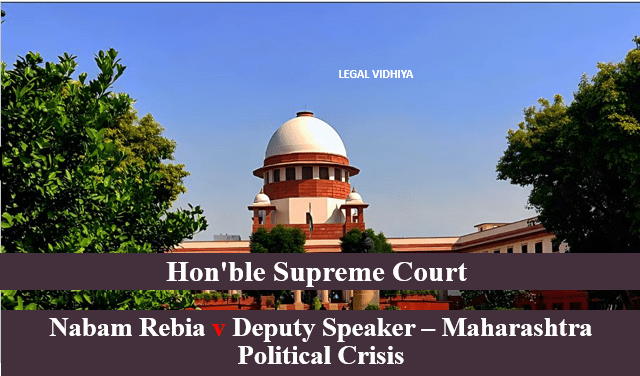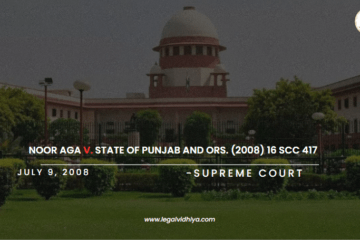
| CASE NAME | Nabam Rebia v Deputy Speaker – Maharashtra Political Crisis |
| CITATION | (2016) 8 SCC 1 |
| DATE OF JUDGMENT | 13th July, 2016 |
| CASE NO | CA 6203-6204/2016 arising out of SLP(C) Nos.1259-1260/2016 |
| CASE TYPE | Political Case (Civil Appeal) |
| PETITIONER | Nabam Rebia, Bamang Felix |
| RESPONDENT | Tenzing Norbu Thongdok |
| BENCH | Jagdish Singh Khehar, Dipak Misra, Madan B. Lokur, Pinaki Chandra Ghosh, N.V. Ramana |
| STATUTES REFERRED | The Constitution Of India – 10th Schedule (Anti-Defection Law) |
INTRODUCTION
Under state government the elected member’s hierarchy is – Governor, Chief Minister, Council of Ministers, Speaker and then Deputy Speaker. In parliamentary democracy like India the convention is that even though the governor has discretionary powers, he has to act on the aid and advice of the chief minister and council of ministers. If the governor calls for a legislative assembly session without consulting the chief minister or council of ministers it would lead to constitutional crises. In the present case a landmark judgement was passed by the Supreme Court in which the speaker was disqualified by deputy speaker in an assembly session arranged by the governor without consulting chief ministers or council of ministers.
In this case the Supreme Court gave judgement in favor of the speaker and against the deputy speaker. But the question of law which is said to be wrongly decided was not restraining a speaker from ruling on disqualification according to anti-defection law while his own disqualification is sought by others. When Maharashtra political crises case was decided whose verdict was opposite to what was decided in Nabam Rebia case which resulted in 5- judge bench led by chief justice D.Y Chandrachud referred the judgement of Nabam Rebia for reconsideration to a seven-judge constitution bench.
FACTS OF THE CASE
- In 2011, Nabam Tuki secured a significant win in the Arunachal Pradesh election by capturing 49 seats out of 60. Yet, by 2015, political unrest surfaced due to internal conflict within the Congress party. A group consisting of twenty Congress members, eleven BJP members, and two independent MLA’s opposed the elected chief minister, expressing doubts about his leadership abilities.
- On November 19, 2015, 13 Assembly members drafted a letter to the Governor, voicing discontent with the Speaker and the administration. At the same time, 21 Congress MLA’s abstained from participating in the meeting, alleging the Chief Minister’s mishandling of funds and purported excessive spending.
- Tensions heightened when the Governor, without consulting the Chief Minister or the Council of Ministers, independently preponed the assembly meeting from January 14th, 2016 to December 16th, 2015. Furthermore, Speaker Nebam Rebia was impeached from his office and appointed a Congress rebel as deputy speaker (Tenzing Norbu Thongdok), leading to the nullification of the disqualification order against 14 rebel congressmen.
- Speaker Rebia’s dismissal was disputed in the Guwahati High Court, challenged as an “extraneous and inappropriate exercise of constitutional authority.” On January 5, 2016, the High Court decided to postpone the disqualification of Congress MLA’s and rejected the Speaker’s plea. It deemed challenging the Governor’s discretion under Article 163 or the legislative process under Article 212 impermissible, considering both actions legally valid and not arbitrary.
- After this ruling, an appeal was filed with the Supreme Court, resulting in the case being referred to a 5-judge panel for deeper scrutiny. The legal battle persisted as the highest court deliberated on the intricate relationship between executive actions, legislative authority, and constitutional discretion amid this political turmoil.
ISSUES RAISED
- Was the Governor’s decision to move the Assembly session to an earlier date in accordance with constitutional principles?
- Is it constitutionally permissible for the Speaker to disqualify MLA’s while there was an ongoing motion for his own impeachment pending before the house?
CONTENTION OF APPELLANT
- Appellant argument centered on the Governor’s discretionary powers as detailed in Article 163 of the Constitution. They stressed that although the Governor possesses discretionary authority, it must consistently adhere to the constitutional framework. The argument emphasized that any exercise of the Governor’s discretion must operate within the Constitution’s limits, maintaining alignment with established constitutional principles and avoiding infringement upon the rights of other constitutional bodies.
- They argued that the Governor’s authority outlined in Article 174 wasn’t entirely discretionary. And it was contended that the Governor’s power to summon or dissolve the legislative meeting should been subjected to specific limitations or required consultation with the relevant authorities like council of ministers.
- The appellant argued that the process specified in Article 179(c) for the removal of the Speaker must strictly adhere to the requirement of “by a majority of all the then members.” This argument aimed to uphold inclusivity in decision-making, emphasizing the vital importance of involving all members as mandated by the Constitution. The appellant emphasized the necessity of ensuring the participation of every member in crucial decisions, especially regarding the Speaker’s removal.
CONTENTION OF RESPONDENT
- The Deputy Speaker has advocated for an understanding of Article 163 that provides the Governor with considerable discretionary powers. This stance suggests a broader perspective on the Governor’s authority, allowing for more flexibility in using discretion in certain circumstances without rigidly adhering to every constitutional provision.
- The Deputy Speaker argued that the Governor’s decisions, particularly when utilizing discretionary powers, should be exempt from judicial review. This argument was based on the belief that actions taken by the Governor, especially those rooted in discretionary authority as outlined in Article 163, should not undergo extensive legal examination or interference from other governmental branches.
- The Deputy Speaker advocated for a broader interpretation of the phrase “members present and voting” in Article 179(c), leaning towards a more inclusive approach to voting. This perspective supported the exclusion of particular members from voting during the Speaker’s dismissal, arguing that the Constitution permits flexibility in determining the voting composition for specific issues within the assembly.
JUDGEMENT
The unanimous decision by a panel of five judges of the Supreme Court stressed that the Governor’s power to call, postpone, or expedite a legislative session is open to scrutiny by the judiciary. The Court cited Article 163, stressing the need for the Governor to collaborate with the Council of Ministers and Chief Minister, thereby limiting the Governor’s discretionary powers within the boundaries of the Constitution. While Article 174 bestows the Governor with the authority to convene or dissolve the State legislature, the Court clarified that these powers are confined to the provisions explicitly stated in Article 174.
The Court, addressing the Speaker’s move to disqualify rebel MLA’s amidst a removal resolution, referenced Article 179(c). It highlighted that the Speaker’s decision bypassed the requirement for a vote by “all the then members” for his removal, ruling it unconstitutional. Emphasizing the importance of due process and inclusive decision-making, the Court underscored the necessity to adhere to such procedures.
The Court nullified the events that resulted in the imposition of President’s Rule and reinstated the former government. To determine the government’s majority, it mandated a floor test, thereby restoring trust in the democratic process and ensuring the revival of the State government in accordance with constitutional mandates rather than political interference.
ANALYSIS
- The Nabam Rebia case of Arunachal Pradesh played a significant role in shaping the judgment regarding the Maharashtra political crisis. In November 2019, Maharashtra witnessed a major political shift as Uddhav Thackeray of Shiv Sena formed the Maha Vikas Aghadi alliance with Congress and NCP, taking charge as Chief Minister after parting ways with the BJP. However, by June 2022, tensions surfaced within the coalition as the BJP gained ground in Rajya Sabha and Council elections.
- Internal strife arose within Shiv Sena as Eknath Shinde and some legislators opposed Thackeray’s leadership, relocating to Gujarat and Assam. This internal power struggle led to Shinde’s removal as Legislature-Party leader by Thackeray, supported by Deputy Speaker Narhari Zirwal.
- Shinde’s group contested their expulsion, alleging an earlier unauthorized attempt to remove Deputy Speaker Zirwal before the disqualification notice. The Supreme Court intervened, granting the rebel lawmakers an extra 12 days to address the disqualification notice.
- Thackeray’s camp challenged the Governor’s call for a floor test. When the Supreme Court declined to halt the test, Thackeray resigned as Chief Minister. The subsequent case revolved around interpreting the Tenth Schedule, dealing with defection-related matters.
- Thackeray’s faction referred to the Nabam Rebia case, seeking a reconsideration by a 7-judge bench. They argued against Speakers facing removal from deciding on disqualification petitions. However, the Constitution Bench deferred an immediate review, intending to evaluate the matter after detailed arguments.
- The Nabam Rebia judgment established a legal boundary limiting the Speaker’s authority concerning disqualification petitions under the Tenth Schedule, which addresses defection. However, in a subsequent review, the bench highlighted two aspects overlooked in the earlier ruling.
- Firstly, concerns were raised about the possible exploitation of the temporary suspension of the Speaker’s functions under the Tenth Schedule. There were worries that lawmakers, whether expecting or facing disqualification petitions, might misuse this temporary suspension for their own benefit. Secondly, the bench expressed worries about potential constitutional gaps resulting from the temporary suspension of the Speaker’s role. It questioned whether this suspension could cause a pause or disruption in applying the Tenth Schedule, casting doubts on its continuous operation and effectiveness.
- The bench acknowledged an unresolved legal issue within the 2016 Nabam Rebia judgment related to disqualifications in Arunachal Pradesh, prompting the need for referral to a larger bench for further deliberation based on the specifics and arguments presented in the current case.
CONCLUSION
The judgment in the Nabam Rebia case emphasized the Governor’s need to act based on the Council’s advice. It also established that the Speaker and Deputy Speaker cannot disqualify an MLA when a motion for their removal is pending. However, issues emerged when the Nabam Rebia case was cited in the Maharashtra political crisis, leading the bench to refer the case to a larger seven-judge bench for reconsideration due to highlighted problems.
REFERENCES
- https://www.scobserver.in/reports/nabam-rebia-deputy-speaker-arunachal-pradesh-presidents-rule-judgment-in-plain-english/
- https://www.hindustantimes.com/india-news/supreme-court-refers-maharashtra-political-crisis-case-to-larger-bench-to-settle-substantial-questions-of-law-on-restraining-a-speaker-101683830616895.html
- https://www.legalserviceindia.com/legal/article-10055-nabam-rebia-and-bamang-felix-v-s-deputy-speaker-governor-s-discretion-and-judicial-review.html
- https://vajiramias.com/current-affairs/nabam-rebia-judgment/5f1f9f591d5def7de79314cd/
- https://aishwaryasandeep.in/case-analysis-of-nabam-rebia-and-bamang-felix-vs-deputy-speaker-2/
- https://www.lawyersclubindia.com/articles/nabam-rebia-judgment-explained-15158.asp
DECLARATION
This Article is written by Fathima Zohra, student of Kristu Jayanti College of Law, Intern at Legal Vidhiya.
Disclaimer: The materials provided herein are intended solely for informational purposes. Accessing or using the site or the materials does not establish an attorney-client relationship. The information presented on this site is not to be construed as legal or professional advice, and it should not be relied upon for such purposes or used as a substitute for advice from a licensed attorney in your state. Additionally, the viewpoint presented by the author is of a personal nature.




0 Comments